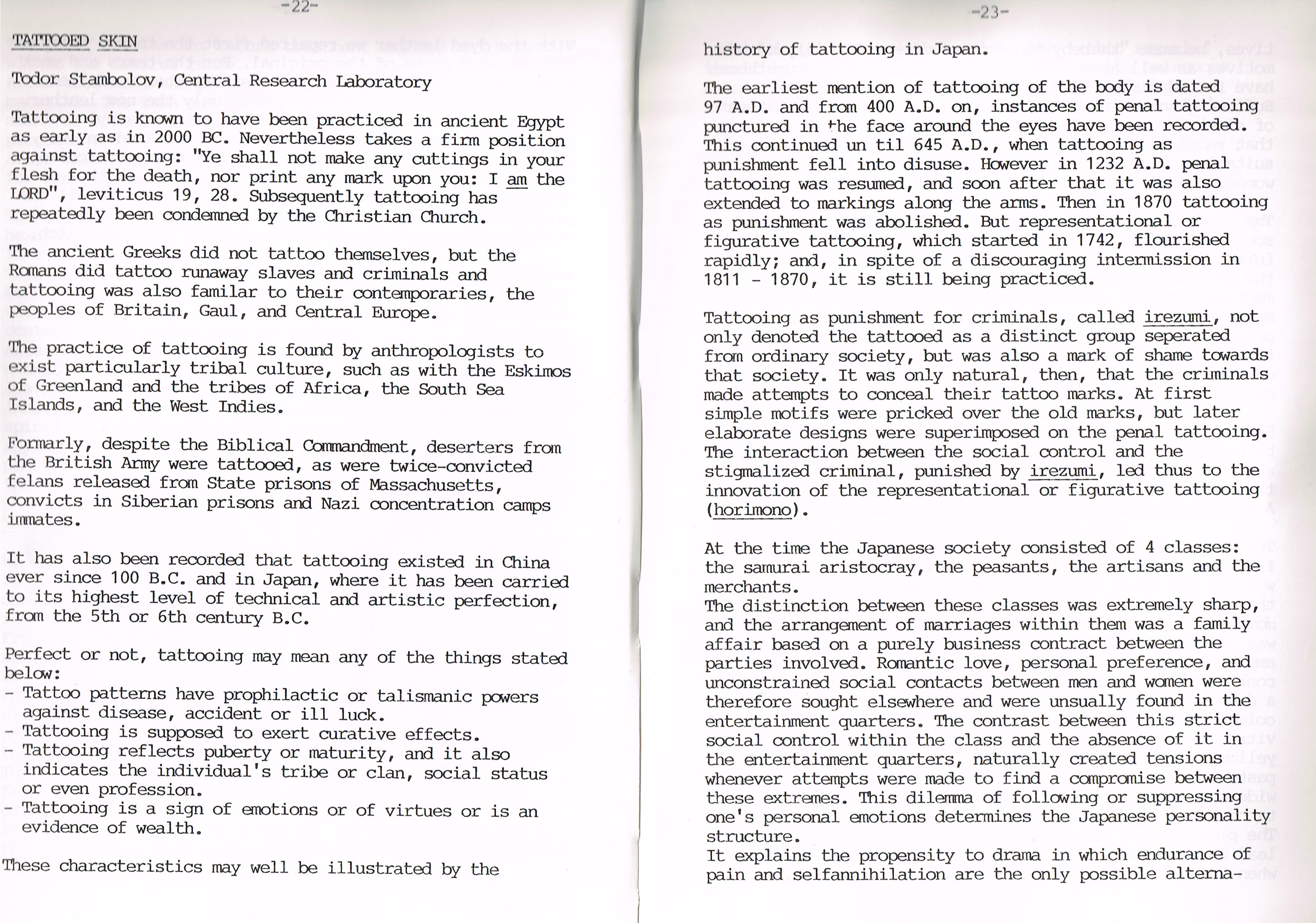CCI20140507�15

-22-
TATTOOEP SKIN
Todor Stambolov, Central Research Laboratory
Tattooing is known to have been practiced in ancient Egypt as early as in 2000 BC. Nevertheless takes a firm position against tattooing: "Ye shall not make any cuttings in your flesh for the death, nor print any mark upon you: I am the IDRD", leviticus 19, 28. Subseguently tattooing has repeatedly been condemned by the Christian Church.
The ancient Greeks did not tattoo themselves, but the Romans did tattoo runaway slaves and criminals and tattooing was also familar to their contemporaries, the peoples of Britain, Gaul, and Central Europę.
The practice of tattooing is found by anthropologists to exist particularly tribal culture, such as with the Eskimos of Greenland and the tribes of Africa, the South Sea Islands, and the West Indies.
Formarly, despite the Biblical Commandment, deserters from the British Army were tattooed, as were twice-convicted felans released from State prisons of Massachusetts, convicts in Siberian prisons and Nazi ooncentration camps immates.
It has also been reoorded that tattooing existed in China ever sińce 100 B.C. and in Japan, where it has been carried to its highest level of technical and artistic perfection, from the 5th or 6th century B.C.
Perfect or not, tattooing may mean any of the things stated belcw:
- Tattoo pattems have prophilactic or talismanic powers against disease, accident or ill luck.
- Tattooing is supposed to exert curative effects.
- Tattooing reflects puberty or maturity, and it also indicates the individual's tribe or elan, social status or even profession.
- Tattooing is a sign of emotions or of virtues or is an evidence of wealth.
These characteristics may well be illustrated by the
history of tattooing in Japan.
The earliest mention of tattooing of the body is dated 97 A.D. and from 400 A.D. on, instances of penal tattooing punctured in *-he face around the eyes have been recorded. This continued un til 645 A.D., when tattooing as punishment fell into disuse. Hcwever in 1232 A.D. penal tattooing was resumed, and soon after that it was also extended to markings along the arms. Then in 1870 tattooing as punishment was abolished. But representational or figurative tattooing, which started in 1742, flourished rapidly; and, in spite of a discouraging intermission in 1811 - 1870, it is still being practiced.
Tattooing as punishment for criminals, called irezumi, not only denoted the tattooed as a distinct group seperated from ordinary society, but was also a mark of shame towards that society. It was only natural, then, that the criminals madę attempts to conceal their tattoo marks. At first simple motifs were pricked over the old marks, but later elaborate designs were superimposed on the penal tattooing. The interaction between the social contro! and the stigmalized criminal, punished by irezumi, led thus to the innovation of the representational or figurative tattooing (horimono).
At the time the Japanese society consisted of 4 classes: the samurai aristocray, the peasants, the artisans and the merchants.
The distinction between these classes was extremely sharp, and the arrangement of marriages within them was a family affair based on a purely business contract between the parties involved. Romantic love, personal preference, and unconstrained social contacts between men and women were therefore sought elsewhere and were unsually found in the entertainment ąuarters. The contrast between this strict social control within the class and the absence of it in the entertainment ąuarters, naturally created tensions whenever attempts were madę to find a compromise between these extremes. This dilemma of following or suppressing one's personal emotions determines the Japanese personality structure.
It explains the propensity to drama in which endurance of pain and selfannihilation are the only possible altema-
Wyszukiwarka
Podobne podstrony:
CCI20140507�01 Editor, P.B. Hallebeek. Thanks are due to S.M. Fontijn and F.L. Regter of the Central
CCI20140507�12 - I 6 Degreasing set up LEATHER JERKIN H. van Soest, P. Hallebeek, Central Research
CCI20101218�021 22 Rys. 15. Schemat przyrządu AEG służącego do hydrostatycznego ciągnienia drutu: 1
CCI20110114�021 22 2.3.6. Wzory tabel wyników pomiarów i obliczeń Tablica 5. Parametry walcowania, w
TOKUE, T., Central Research Institute of Electric Power Industry, 1646 Abiko, Abiko 270-11 TOM I NAG
CCI20111204�035 4.,]22£Ui . pejUj hQiJ&4&AA& ........ .‘i...... ......łAl- ^"UiCu:
CCI20130725�020 22 1. Ścieki Uch charakterystyka biochemicznej. Z drugiej strony temperatura przyspi
CCI20131112�06 22 Rozdział pierwszy. Obraz w powiększeniu kobiecej płodności par exellence, i imella
CCI20140507�18 TANNKI) HUMAŃ SKIN (Summary) Werner Schmitzer Because of the belief that the bodies o
CCI20140507�19 - ju- the same time most of the moisture in the skin evaporates, hence the shrinkage.
img052 (22) right front. Right front: Next row: (WS) K4, ssk, knit to last 6 sts, k2tog, k4—2 sts&nb
skanuj0021 (22) !. CZYSTE KULTURY I KULTURY MIESZANE: HODOWLA ZŁOŻONA TYLKO Z JEDNEGO GATUNKU DROBNO
S ONECZNIKIN130053bd1f0 miejsce na nadruk2 1 i i L 8 9 10 u 1? ,6 17 18 19 20 2[ 22 2S 26 2? 28 29i
więcej podobnych podstron